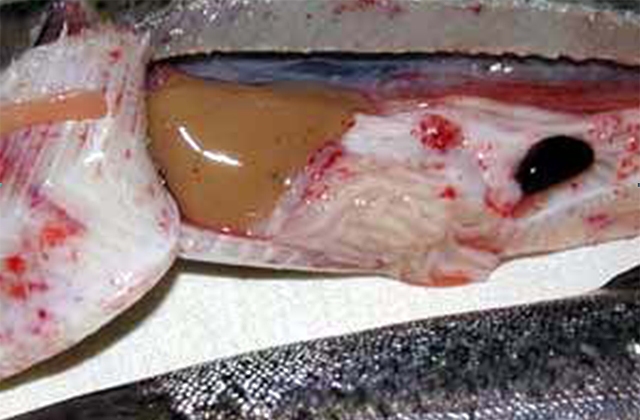What is VHS and what causes it?
Viral hemorrhagic septicemia (VHS) is a serious, highly contagious and fatal disease of fish. It affects a large number of fresh and marine fish species. The disease has occurred in farmed rainbow trout in Japan and Europe and in wild marine fish in the Atlantic and Pacific Ocean and the Baltic Sea. The virus was first reported the Great Lakes region of North America in 2005. State and federal governments are currently involved in disease education and control efforts.
What fish get VHS?
VHS affects over 40 different species of fish. This includes a number of important recreational, sport and commercial fish species such as salmon, trout, yellow perch, sunfish, muskellunge, walleye, northern pike and a number of minnow species.
How do fish get VHS?
VHS is highly contagious. The greatest risk for transfer of the virus is the movement of infected fish or contaminated water. The VHS virus is shed in the urine and reproductive fluids (ovarian fluids, sperm) of infected fish. Fish can be exposed by direct contact with infected fish or contaminated water. Objects (fomites) in contact with infected fish, such as nets, buckets, footwear and vehicles can also serve to spread the virus to additional locations. Fish can also be exposed by ingesting (oral) infected fish (e.g., predation or cannibalism). Fishpreying birds or mammals (vectors) may carry infected fish to other
How does VHS affect fish?
Fish infected with VHS may have hemorrhages on the body, eyes, gills, or at the base of the fins, bulging eyes (“pop-eye”), swollen (fluid-filled) abdomens, and darkened coloration. Affected fish may have abnormal swimming behavior. Hemorrhages may also be seen in the muscle and organ tissues. Some fish infected with VHS may show no signs of illness, but can still spread the virus and infect other fish. Most VHS outbreaks occur in the spring when water temperatures are less than 5°C (59°F). Deaths from VHS rarely occur at temperatures above 18°C (64°F). VHS has caused large scale fish die offs. Reported death rates in some species of fish have been as high as 80-100%.
Can I get viral hemorrhagic septicemia?
No. VHS has not been reported to affect people. Fish carrying the virus are safe to eat and handle.
Who should I contact if I suspect VHS?
Contact your state department of natural resources or state aquaculture coordinator if you suspect VHS.
How can I protect my fish from VHS?
Aquaculture facilities should use biosecurity procedures to protect fish from exposure to infected fish or contaminated water or equipment. This includes quarantining incoming fish, cleaning and disinfecting equipment, vehicles, and footwear. When fishing or boating, boats, nets and other equipment should be drained and cleaned before moving to another location. Do not move fish, including baitfish from one body of water to another. VHS is susceptible to a number of disinfectants including sodium hypochlorite (bleach) and iodophor (iodine solutions). Federal and state regulations on the trade and transport of VHS susceptible species have been made in efforts to control the further spread of the disease.









